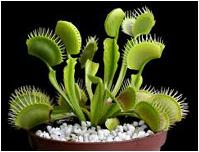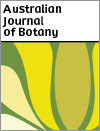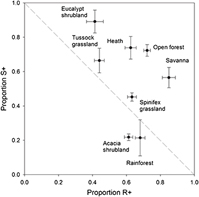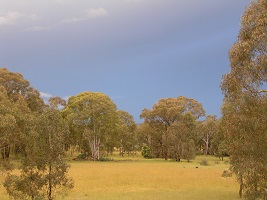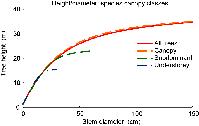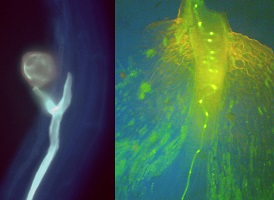Australian Journal of Botany
Volume 70
Number 2 2022
Carnivorous plants acquire nutrients by several mechanisms, including insect predation, root uptake, litterfall, atmospheric deposition and defecation by mutualistic animals. The relative importance of these nutrient sources for a range of terrestrial and aquatic species with a wide geographical distribution was estimated by 15N stable-isotope tracing.
Fire drives resilience trait combinations (postfire resprouting: R+, versus postfire seedling recruitment: R+) shaping plant assemblages in Australian ecosystems. R+ and S+ are negatively correlated at the ecosystem level. R+ is most prevalent in productive fire-prone habitats where there are sufficient resources to support postfire resprouting. S+ is most prevalent under severe crown fire regimes that have a high likelihood of topkilling woody plants. High proportions of R+ and/or S+ emphasise the highly fire-adapted nature of most Australian ecosystems.
A 15-year study of woodland, forest and derived grassland found Rytidosperma species to vary widely in habitat preferences, but overall to be more abundant and persistent at open sites on upper slopes. Where relative abundance declined after macropod grazing replaced sheep grazing, annual exotic grasses and forbs, native sub-shrubs and low-palatability graminoids became dominant. There may be some implications of the observed changes for conservation management of the threatened golden sun moth.
Understanding how genetic variation is shared between species is important for managing biological diversity. There are only three bloodwood tree species in south-western Australia and the species are closely related through shared ancestry. Genetic differentiation was higher among species with patchy distributions, whereas diversity was lower only in the species with a highly localised range, and probably indicates the impact of severe reductions in population size in species with very restricted distributions.
Process rate equations (generalised Michaelis–Menten, GMM, and non-rectangular hyperbola, NRH) described rainforest tree height–diameter relationships more precisely than did biophysical or growth rate equations. The GMM was the most efficient for modelling but the NRH best visualised interactions between stem structure and tree architecture from saplings to maturity for understorey to upper-canopy species.
Casuarina species are extensively planted in the tropics for wood production and environmental services. Interspecific hybrids with desirable combinations of characters will increase plantation productivity. Controlled-pollination studies involving C. equisetifolia, C. junghuhniana and C. cristata showed that they can be hybridised. Fertilisation happened after 45–50 days and chalazogamy was observed in all pistils studied. No major pre-fertilisation barrier was found and post-zygotic selection may be the reason for variation in hybridisation success.
